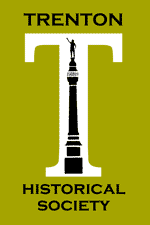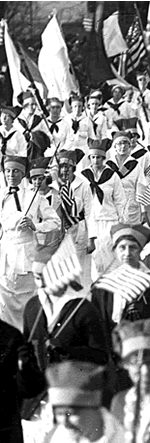



From South Broad Street down to South Warren Street, the Assunpink flows
within a culvert that was constructed as part of major episode of urban land-scaping
and demolition in the early 1960s. The creek enters the culvert immediately
below the downstream face of the South Broad Street bridge and flows beneath
a manmade swale-like landform to South Warren Street (Plate
B. 34). It emerges into an open channelized creek immediately downstream
from South Warren Street where it passes behind the Marriott Conference Hotel
at Lafayette Yard and between the abutments of the former aqueduct of the
Trenton Water Power. The "swale" is grass-covered, contains a small children's
playground and is bordered by Factory Street to the south and the New Jersey
Department of Human Services office building (Capital Place One, 222 South
Warren Street) and East Lafayette Street to the north (Plates B.
35, B. 36 and B.
39). While there are no visible surface historic features within this
section of the study area, there is a reasonable potential for buried remains
relating to the numerous milling operations that lined this section of the
Assunpink.
South Broad Street crosses the Assunpink Creek over a historic masonry structure
that shows evidence of multiple building, rebuilding and repair episodes.
The downstream façade of the bridge displays a large stone arch formed with
a dressed keystone and vous-soirs and random laid, rough-dressed facing stones
(Plate B. 37). A companion arch
to the south is now buried beneath fill. The bridge is believed to contain
elements of an 18th-century (and perhaps even late 17th0-century) structure,
but its exterior appearance mostly reflects modifications undertaken in the
19th and 20th centuries. Major rebuilding episodes occurred in 1843 and 1870.
The bridge is currently the subject of a detailed historical and structural
analysis, pending decisions about its rehabilitation, restoration or replacement.
On the east side of South Broad Street, north of the creek, a plaque on the
brick perimeter wall of Mill Hill Park details one of many notable historical
events in the immediate area – the ladies of Trenton's honoring of George
Washington on April 21, 1789, as he passed over the Assunpink en route to
his inauguration as the first President of the United States (Plate
B. 38).
From the south bank of the Assunpink at the South Broad Street crossing,
clear views may be obtained across town to the New Jersey State House area
and the Trenton Battle Monument (Plates B.
39 and B. 40). Southward, the
view is along South Broad Street, where a mixture of 20th-century buildings
now mostly exists. A notable structure along the east side of South Broad
Street is the three-story Norman Revival Van Sciver building that was erected
by a local furniture company in 1931 (Plate
B. 41). The site of Mahlon Stacy's and subsequent mills is judged to lie
partly beneath South Broad Street, but mostly under the low brick commercial
building at 100 South Broad Street (Plate
B. 42). While this general vicinity has clearly been heavily modified
over the years, both during the various reconfigurations of the mill facilities
up into the mid-19th century, and then through the creation of the Assunpink
Block and a more recent late 20th-century cycle of redevelopment, there is
unquestionably a very high potential for significant deep-buried industrial
remains. Two plaques on the side of the Assunpink Creek at the entry into
Mill Hill Park, just down slope from the mill site, witness the former existence
of the mill site and the role of this location in the Second Battle of Trenton
(Plate B. 43).
Moving upstream from the South Broad Street bridge along the south bank
of the creek, there is ample evidence of some of the later 19th-century reworking
of the mill hydropower system that fed not only the Trenton Mills/ Eagle Carding
Mill. McCall paper Mill site, but also the Eagle Cotton Factory and the Trenton
Cotton Factory/ Wilson Woolen Mill sites downstream of the bridge. Elements
of earlier 19th-century -and probably also 18th-century -construction may
still be visible among the multiple foundations ranged along this section
of the creek (Plates B. 44 and
B. 45). The landscaping involved
in the creation of Mill Hill Park in the early 1970s incorporated and stabilized
many of these foundations in the course of creating new features like the
amphitheater (Plate B. 46). The
length of walling running longitudinally in the middle of the creek just upstream
of the South Broad Street bridge is part of the support system constructed
for the Assunpink Block in the 1870s (Plate B. 47).
Numerous traces of foundations are present in the ground surface within the
park between Livingston Street and the creek. These relate to various structures,
including a late 19th-century electric facility, residential buildings and
outbuildings.
The Jackson Street bridge, a decommissioned road bridge, is a Pratt Truss
structure erected in 1888 (Plate B.
45). The bridge was fabricated by the New Jersey Steel and Iron Company
at their plant in South Trenton. It is listed as a contributing element in
the Mill Hill Historic District (Greiff and Ashton 1976). The stretch of the
creek extending upstream to the South Montgomery Street bridge from the Jackson
Street bridge has been extensively channelized. The river banks have been
stabilized and the retaining structures hold back fill that lies within the
former mill pond (Plates B. 48
and B. 49). There are likely to be archaeological
remains of the mid-19th-century retreat known as Washington's Retreat surviving
in this area.
The South Montgomery Street bridge, with its double span stone arch, was
erected in 1873. It also boasts a cast iron railing fabricated at the James
D. Field Ironworks. A row of late 19th-century three-story brick houses lines
the west side of South Montgomery Street just north of the bridge and fronts
on to Douglas Place, the center piece of which is an Italian marble statue
of George Washington crossing the Delaware (Plates B.
50 and B. 51). This statue
was initially displayed at the Centennial Exposition in Philadelphia in 1876.
It was subsequently bought by the City of Trenton in 1892 and erected in Cadwalader
Park. It was relocated to Douglas Place in 1976 as part of a bicentennial
project that was intended to increase the focus on the nearby Douglass House,
a five-times sited, four times moved, 18th-century frame dwelling that Washington
used as a headquarters on the eve of the Second Battle of Trenton (Plates
B. 52 and B.
53). The house presently sits on the south side of East Front Street,
west of South Montgomery Street.
The north bank of the Assunpink between the Douglass House and South Broad
Street, all contained within Mill Hill Park, is mostly composed of an open
grassy space crossed by a few formal and informal pathways (Plate
B. 54). A plaza-like area exists at the corner entrance to the park in
the southeast angle of the East Front Street/ South Broad Street intersection
(Plate B. 55). The western end
of this area is probably of minimal archaeological interest, since a large
department store building was located here whose construction and demolition
likely resulted in substantial ground disturbance (Plate
B. 25). Further east, however, are the sites of several buildings, notably
the Atheneum theater, of which there may well be surviving archaeological
remains. There are no surface traces of historic features in this section
of the park.
Up To Top /
Home
The Society : About Us / Artifacts
Committee / Education Committee / Preservation
Committee / Membership / Contact
Us / Events
Our History : Sights & Sounds
/ 1929 History / Old
& New / Hill Diaries / Chronological
Indexes / Trenton Made / Documents / Tours
Your Ancestors : Research Services
/ Obituaries / City
Directories / High School Yearbooks /
Cemeteries / Genealogy
The City : Buildings /
Historic Districts / North
Ward Survey / Street Names / Local
Links
Search Our Site
Up
To Top / Home
The Society : Preservation
Committee / Artifacts Committee / Membership / Contact
Us / Events
Our History : Sights & Sounds / 1929
History / Old & New / Hill Diaries/ Chronological
Indexes / Trenton Made
Your Ancestors : Research Services / Obituaries / City
Directories / High School Yearbooks / Cemeteries
The City : Historic Districts / North
Ward Survey / Street Names / Local Links